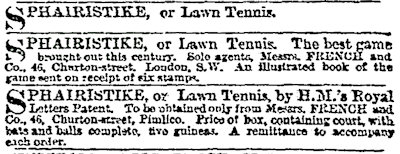Sphairistike
This was an ancient Greek term, meaning skill in playing at ball, which Major Walter Wingfield borrowed for the recreation he patented in 1874, in part a conflation of elements borrowed from earlier games: the net from badminton, the ball from fives, and the scoring from racquets.

The first advertisement for Sphairistike, in The Times on 25 Apr. 1874. The repetitions are to make the ad more visible on the crowded front page.
The name was never popular, not least because only those few people well versed in ancient Greek knew how to say it (the Morning Post complained about this in August 1874). Most converted it into a three-syllable word that roughly rhymed with “pike”. This was soon abbreviated either to sticky or to the mock-French stické; some early writers Frenchified the full name by adding an accent: Sphairistiké.
Luckily, as the advertisement above shows, Major Wingfield also called his new game lawn tennis, a name chosen to distinguish it from the much older indoor game then called simply tennis. This immediately caught on, though noticed only dismissively by practitioners of more established games, as in this cricket report later in the spring:
We also observed a further accessory for the amusement of ladies in the shape of “Lawn Tennis,” on the croquet ground at the north side of the carriage drive.
Daily News, 7 May 1874.
A modified version of his game immediately became hugely popular under that name, though it was soon abbreviated just to tennis, so that the aficionados of the older game in snobbish retaliation started to call theirs by the retronym real tennis, a term later mistakenly converted to royal tennis in Britain and some other countries.

